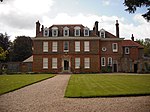East Stow Rural District
Districts of England created by the Local Government Act 1894History of SuffolkRural districts of EnglandUse British English from August 2012

East Stow was a rural district in East Suffolk, England from 1894 to 1934. It was created under the Local Government Act 1894, from the part of the Stow rural sanitary district that was in East Suffolk (the rest forming Thedwastre Rural District in West Suffolk.) Its name derives from the historic hundred of Stow, whose boundaries it closely matched. It was abolished in 1934 under a County Review Order. Its area went to form part of Gipping Rural District, with a small part being transferred to Stowmarket urban district. In 1974 the area became part of Mid Suffolk district.
Excerpt from the Wikipedia article East Stow Rural District (License: CC BY-SA 3.0, Authors, Images).East Stow Rural District
Lower Road, Mid Suffolk
Geographical coordinates (GPS) Address Nearby Places Show on map
Geographical coordinates (GPS)
| Latitude | Longitude |
|---|---|
| N 52.19 ° | E 0.96 ° |
Address
Lakeside Fishing and Caravan Park
Lower Road
IP14 3BX Mid Suffolk
England, United Kingdom
Open on Google Maps







